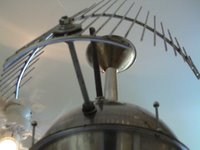
Refrigerator grates now have made it into six of the last eight instruments I have built. I still feel like I have not yet captured the soul of my fridge yet. There are some things that man should just never understand.
This one is a bit different in that I turned what has been a recent problem of things leaking in my fridge into an artistic solution where I just add water before hand. That’s right, this new one needs water to reach its full potential. This isn’t my first attempt at water based instruments and probably won’t be my last. The first was the Water Fisher Tube which worked out alright, but never really saw the light of day. I built it and immediately hung it in a bar. The second was the Round Bowed String Thing. Which saw a bit more action. It has traveled around in different art shows, been used live on stage, and is in the process of being recorded for an album (or something similar to whatever a group recording noises of experimental instruments can be). The Hydrofridge-a-phone
the Round Bowed String Thing. Which saw a bit more action. It has traveled around in different art shows, been used live on stage, and is in the process of being recorded for an album (or something similar to whatever a group recording noises of experimental instruments can be). The Hydrofridge-a-phone
is just an evolutionary process of building. All my contact points are sealed with water resistant silicon, the chamber of the instrument is free of obstructions, and for this one I had the foresight to add an air hole for easy draining. I’m guessing it holds about 120 ounces of liquid, but really I think about twenty to thirty ounces might be enough to do the trick. What trick you ask? It’s the trick of messing with the pitch of the instrument; you can add as little or as much as you like, though I suspect there is probably a cutoff point. Once you have added the water, start bowing the refrigerator tines. As you do this just slowly turn the instrument on an angle, swishing around the water inside. If all goes well you will start to hear the pitch of the tines start to bend slightly.
the trick of messing with the pitch of the instrument; you can add as little or as much as you like, though I suspect there is probably a cutoff point. Once you have added the water, start bowing the refrigerator tines. As you do this just slowly turn the instrument on an angle, swishing around the water inside. If all goes well you will start to hear the pitch of the tines start to bend slightly.
The best example I can think of where this technique is used to its fullest potential would be an instrument designed by Richard Waters called the Waterphone. Not only is it quite lovely to look at, but it is also a beautiful sounding instrument.
Maybe one day I too can have an instrument I’ve designed be named after me. Inerphone is too obvious, but how about the Inertar, no wait I think I’ll call it the Inerimbau, or the Ineriano. Yeah, these are all stating to sound great; I think I’ve spent too much time out of the spaceroom.
instrument I’ve designed be named after me. Inerphone is too obvious, but how about the Inertar, no wait I think I’ll call it the Inerimbau, or the Ineriano. Yeah, these are all stating to sound great; I think I’ve spent too much time out of the spaceroom.
Time to recompress.
Iner out.


No comments:
Post a Comment